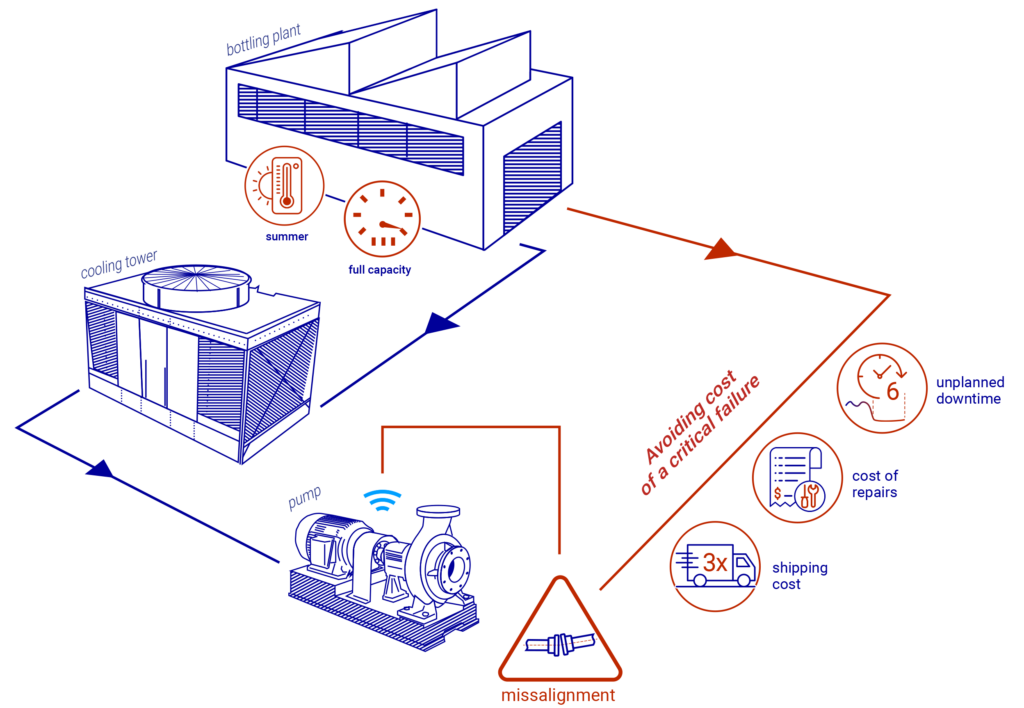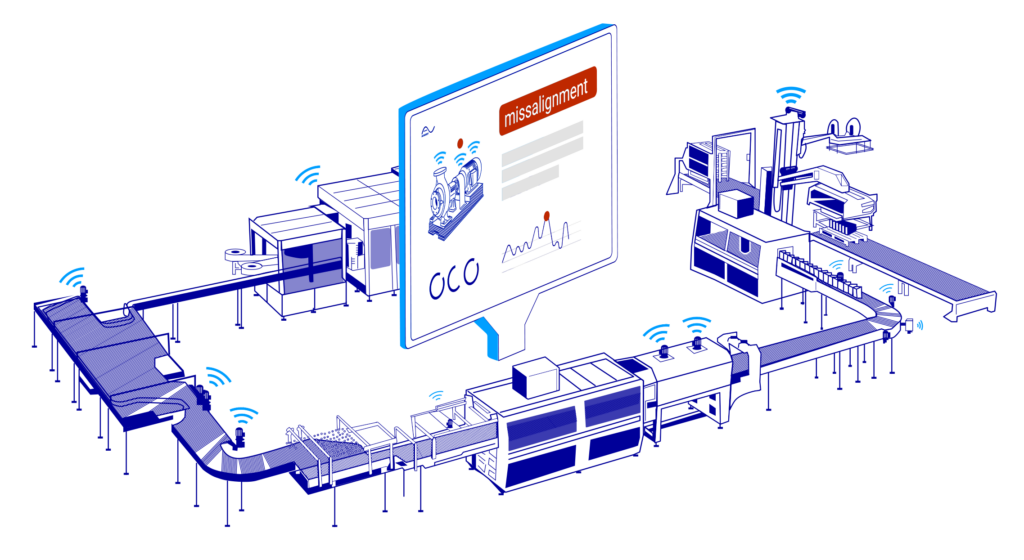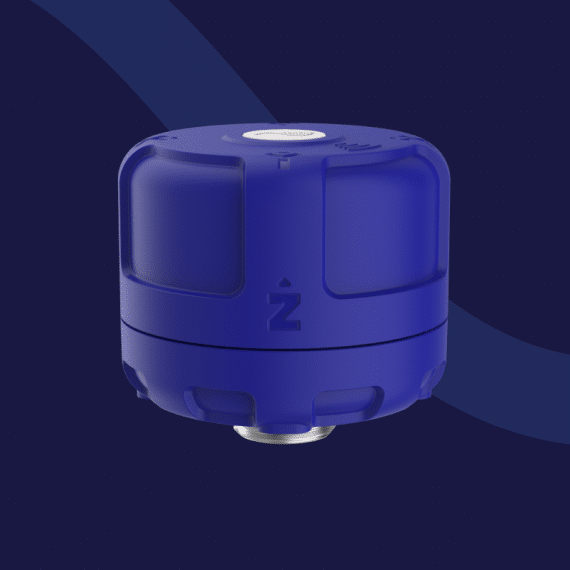
When the alert came, the site reliability leader knew he had to act fast. A sensor had diagnosed misalignment in a critical cooling tower pump — and the timing couldn’t have been worse. The bottling plant was already operating at full capacity, preparing to meet rising demand as temperatures increased, and summer approached.
There was no doubt. If the cooling tower went down, the entire production line would have to be taken down until it was repaired.
He started to mentally calculate the potential cost of a critical failure while he rallied his repair team: around six hours of unplanned downtime, plus an unknown cost in repairs. They’d have to ship product out-of-network, at triple the cost — if the product wasn’t ruined while waiting. Failure wasn’t an option, but at least they knew exactly what was wrong with the machine.

Heeding their condition monitoring system’s early warning, the repair task was booked as the priority for the next scheduled downtime later that week. The early detection allowed the maintenance team to plan beforehand and pull the spare parts needed. They repaired the machine with the advance knowledge of exactly what was wrong with the cooling tower pump, installing a new motor and coupling to prevent further malfunctions. In the end, the cost was a fraction of what it might have been and they avoided unnecessary downtime — needless to say, the entire team went out for celebratory drinks after work.

Over the next few weeks, three more of the company’s plants avoided similar shutdowns, strengthening the business case for digitizing machine health management. At another plant, a misaligned reverse osmosis pump was quickly detected and realigned, saving eight hours of full plant shutdown. And at two more plants, early detection of worn bearings in crucial production components helped avoid hours of line downtime, huge repair expenses, and as much as 24 hours of full plant shutdown.
Planning Ahead with Machine Health Monitoring
Not every bottling company is as lucky or as forward thinking. Even though the bottling industry is growing fast—the bottled water market alone is expected to be valued at $307.2 billion just five years from now—it isn’t capitalizing on opportunities to improve overall machine health. Rather than focusing on universally digitizing machine health, the bottling industry has focused on sensors that just detect general breakdown in a few select process machines, such as fillers or blow molders.
This presents the bottling industry with a huge opportunity for better productivity: by monitoring the overall health of both utility and production equipment, facilities can greatly reduce outages, downtime and associated losses. OEMs may step in to solve performance issues with their own production equipment by providing green light/red light alerts, but more sophisticated root cause analysis (RCA) can help predict and solve malfunctions before they cause problems and production interruptions. Not to mention that having RCA helps you from preventing that malfunction from recurring in the future.
Current industry competition means bottling operations are striving to produce more, in tighter time frames, with fewer resources at their disposal. This pressure to produce creates risk — one overlooked or downplayed issue in a system working at full capacity can lead to disaster. The need for machine health initiatives that affordably protect production capacity has never been more urgent.
Part Of A Larger Digital Transformation Strategy
Machine health solutions are the foundation of a successful digital transformation strategy. Our expertise in the bottling market has supported digitization efforts at six of the top ten bottling companies worldwide. We’ve implemented machine health initiatives facility-wide across plastic, glass, and can lines on both process and supporting equipment. Our success comes from working hand-in-hand with corporate and facility leaders to drive value at the site while also tracking and quantifying the gains towards a larger machine health monitoring implementation. Combining the work we do at the facility level with corporate oversight and sponsorship has been critical to our bottling industry success.
When assessing a bottling facility’s needs, it’s important to consider how digitizing machine health contributes to an effective and scalable solution. The health of every asset in a production line contributes to the health of the facility and downtime-free operations and it’s important to understand the similarities but also differences in production. For example, a general bottling operation requires sensors on the main drives of core machines and pumps. Fluid movement monitors would also be installed, as well as sensors for packers, fillers and labelers. For a plastic bottling line, it’s important to also monitor the blow mold equipment, while for glass bottling, it’s the capper, and for can lines, the seamer.
The Value of Digitizing Machine Health
In a fast-growing and highly competitive industry like bottling, digital machine health delivers a competitive advantage. We’ve boosted the productivity of half a dozen leading bottling companies by implementing digitized machine health management — thereby increasing their operational efficiency and uptime.
The elimination of unplanned downtime plus the early detection on repairs delivers fast ROI, with payback typically coming within the first six months. With better Overall Equipment Effectiveness (OEE), more product can be made and shipped, significantly reducing or eliminating the risk and cost of expensive out-of-network shipments and third-party transportation.
The bottom line is that investing in digitized machine health pays for itself, and it pays fast. In a facility operating three plastic lines with annual cumulative mechanical downtime of 500 hours, and a conservatively estimated cost of at least $500 per hour of line downtime — eliminating downtime would save $250,000 in the first year, easily paying back the initial investment.
When it comes to the effectiveness of machine health initiatives for bottling plants, the numbers speak for themselves.
Click here if you want to talk about machine health at your bottling facility.






